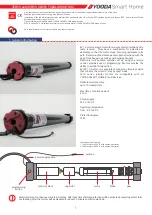
4TNV98 & 4TNE98 Diesel Engine
Section 3. Engine
126
Figure 6-123
Inspection of Camshaft Bushing and Bores
1.
Measure the I.D. of the front bushing and the
remaining bores in the cylinder block. See
Camshaft on page 68 for specifications.
2.
If the camshaft bushing is not within specification,
replace it using the appropriate service tool. If the
remaining bores are not within specification, the
cylinder block will require replacement as there
are no bearing inserts used.
Inspection of Idler Gear and Shaft
1.
Measure the outside diameter
(Figure 6-124, (1))
of the idler gear shaft
(Figure 6-124, (2))
. See
Idler Gear Shaft and Bushing on page 69 for
specifications.
2.
Measure the inside diameter
(Figure 6-124, (3))
of the idler gear bushing
(Figure 6-124, (4))
. See
Idler Gear Shaft and Bushing on page 69 for
specifications.
Figure 6-124
Honing and Boring
Pistons must move freely in the cylinders while
maintaining adequate compression and oil sealing.
If the cylinder walls are scuffed, scored, out-of-round,
or tapered beyond specifications, rebore and hone
to restore cylinders to usable condition. Slight
imperfections can be corrected by honing alone.
1. Boring
- Significant cylinder damage may be
corrected by boring the cylinder to an oversize
dimension. Refer to the appropriate parts catalog
for available oversize pistons and piston rings.
• Boring a cylinder should always be done in a
properly equipped machine shop.
• A bored cylinder should always be finished with a
hone to properly prepare the cylinder surface so
the new piston rings will seat properly.
• After the cylinder has been bored and honed,
install the appropriate oversize pistons and
piston rings.
2.
Honing
- Minor cylinder imperfections may be
corrected by using a rigid cylinder hone
(Figure 6-
126, (1))
. Be sure not to exceed the maximum
cylinder bore specification.
Deglazing
- A used cylinder that did not require
boring or honing, should always be deglazed with
a ball hone
(Figure 6-126, (2))
before installing
new piston rings. This will properly prepare the
cylinder surface to allow new piston rings to seat
properly.
NOTE
: When honing a cylinder, with either a ridged
hone or a ball hone
(Figure 6-125, (1))
, move the
rotating hone up and down in the cylinder bore to
accomplish a 30° to 40° crosshatch pattern
(Figure
6-125)
. This will provide the ideal surface for the
proper seating of new piston rings.
Содержание 4TNV98
Страница 2: ......
Страница 4: ......
Страница 8: ......
Страница 89: ...4TNV98 4TNE98 Diesel Engine Section 3 Engine 87 4TNE98 Engine Figure 6 1...
Страница 111: ...4TNV98 4TNE98 Diesel Engine Section 3 Engine 109 Crankshaft and Camshaft Components Figure 6 84...
Страница 171: ...4TNV98 4TNE98 Diesel Engine Section 4 Fuel System 169 Fuel System Components Figure 7 1...
Страница 173: ...4TNV98 4TNE98 Diesel Engine Section 4 Fuel System 171 Structure And Operation Of Fuel Injection Pump Figure 7 3...
Страница 216: ...4TNV98 4TNE98 Diesel Engine Section 6 Lubrication System 214 Lubrication System Diagram Figure 9 1...
Страница 225: ...4TNV98 4TNE98 Diesel Engine Section 7 Starter Motor 223 Starter Motor Troubleshooting...
Страница 242: ...4TNV98 4TNE98 Diesel Engine Section 8 Troubleshooting 240 Troubleshooting Charts...
Страница 243: ...4TNV98 4TNE98 Diesel Engine Section 8 Troubleshooting 241...
Страница 244: ...4TNV98 4TNE98 Diesel Engine Section 8 Troubleshooting 242...
Страница 246: ...4TNV98 4TNE98 Diesel Engine Section 8 Troubleshooting 244 4TNE98 Engine...
















































